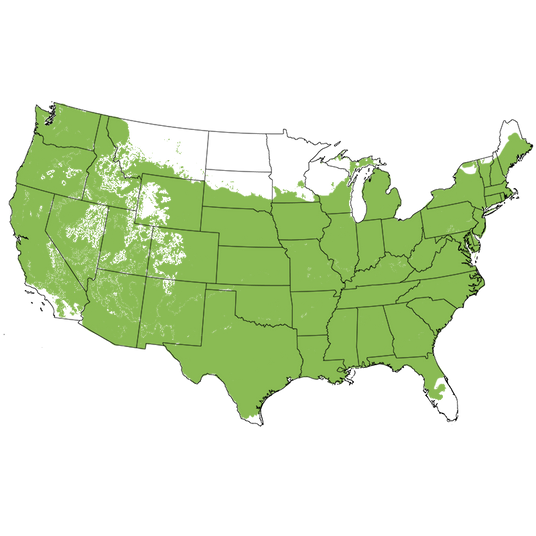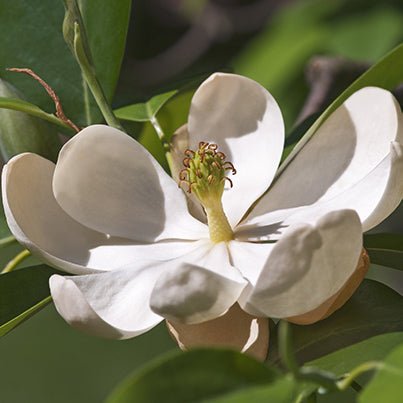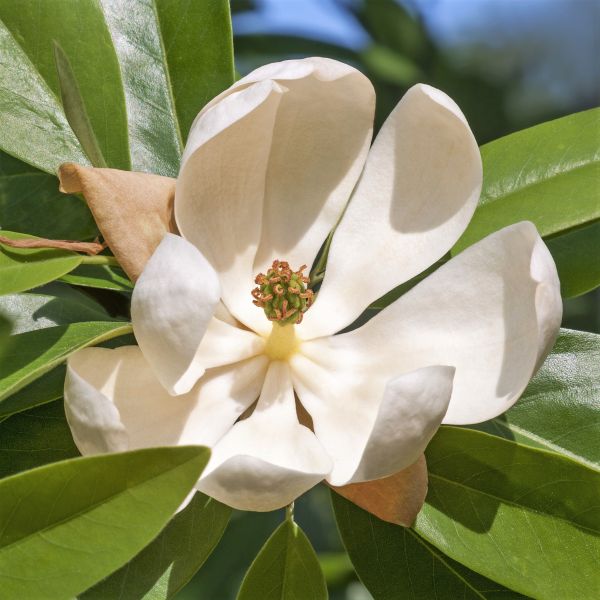Sweet Bay Magnolia Tree
Magnolia virginiana
Plant Sentry™
Plant Sentry™

Plant Sentry™ Protected
Your order is protected by our compliance system that:
- Prevents restricted plants from shipping to your state
- Ensures plants meet your state's agricultural requirements
- Protects gardens from invasive pests and diseases
Delivery and Shipping
Delivery and Shipping
Delivery and Shipping
Fast, Safe Plant Delivery
Ships in 3-4 business days • Tracking provided • Weather protected
| Under $50 | $9.99 |
| $50 - $99.99 | $14.99 |
| $100 - $149.99 | $16.99 |
| $150 - $198.99 | $24.99 |
| $199+ | FREE |
✓ Zone-specific timing • ✓ Professional packaging • ✓ Health guarantee
Understanding Plant Options
Nature Hills offers plants in two main formats:
- Container Plants: Grown in pots with soil, sized by container volume and plant age
- Bare Root Plants: Dormant plants without soil, sized by height measurements
Container Plant Sizes
Container sizes indicate plant age and growing capacity rather than liquid volume equivalents. Our containers follow industry-standard nursery "trade gallon" specifications, which differ from standard liquid gallon measurements.
Young Plants (6 months to 18 months old)
| Container Size | Actual Volume | Metric Equivalent |
|---|---|---|
| 2" x 2" x 3" | 0.18 - 0.21 dry quarts | 0.20 - 0.23 dry liters |
| 4" Container | 0.31 - 0.87 dry quarts | 0.35 - 0.96 dry liters |
| 4.5" Container | 0.65 dry quarts | 0.72 dry liters |
| 6" Container | 1.4 dry quarts | 1.59 dry liters |
| 1 Quart | 1 dry quart | 1.1 dry liters |
| 5.5" Container | 1.89 dry quarts | 2.08 dry liters |
Established Plants (18 months to 2.5 years old)
| Container Size | Actual Volume | Metric Equivalent |
|---|---|---|
| 2 Quart | 2 dry quarts | 2.2 dry liters |
| #1 Container | 2.26 - 3.73 dry quarts | 2.49 - 4.11 dry liters |
| 5" x 5" x 12" | 3.5 - 4.3 dry quarts | 3.85 - 4.74 dry liters |
Mature Plants (2-4 years old)
| Container Size | Actual Volume | Metric Equivalent |
|---|---|---|
| #2 Container | 1.19 - 1.76 dry gallons | 5.24 - 7.75 dry liters |
| #3 Container | 2.15 - 2.76 dry gallons | 8.14 - 12.16 dry liters |
Large Plants (3-5 years old)
| Container Size | Actual Volume | Metric Equivalent |
|---|---|---|
| #5 Container | 2.92 - 4.62 dry gallons | 12.86 - 20.35 dry liters |
| #6 Container | 5.25 - 6.01 dry gallons | 23.12 - 26.42 dry liters |
| #7 Container | 5.98 - 6.53 dry gallons | 26.34 - 28.76 dry liters |
Bare Root Plants
Bare root plants are sold by height from the root system to the top of the plant. Plants may exceed minimum height requirements.
Common Sizes:
- Trees: 1 foot, 2 feet, 3 feet, 4 feet, 5 feet, 6 feet
- Shrubs & Perennials: 1 foot, 18 inches, 2 feet
Important Notes
Container Volume Specifications
- Trade Gallon Standard: Our containers follow industry-standard "trade gallon" specifications established by the American National Standards Institute (ANSI Z60.1) for nursery stock
- Volume Variations: Actual soil volume may vary due to plant root systems and growing medium settlement
- Age Indicators: Container size primarily indicates plant age and maturity rather than liquid volume equivalents
Growing Conditions
- Plant size can vary based on variety and growing conditions
- Container size helps indicate plant maturity and establishment level
- Larger containers generally mean more established root systems and faster landscape establishment
Seasonal Availability
- Bare root plants are available seasonally when dormant
- Container plants are available throughout the growing season
- Specific varieties may have limited availability in certain sizes
Questions?
For questions about specific plant sizes or availability, please contact our plant experts who can help you choose the right size for your landscape needs.

Plant Sentry™ Protected
Your order is protected by our compliance system that:
- Prevents restricted plants from shipping to your state
- Ensures plants meet your state's agricultural requirements
- Protects gardens from invasive pests and diseases
Plant Profile & Growing Essentials
Cold hardy, Native, Fragrant, Flowering, Wet Soils, Thornless, and Attracts pollinators
Specifications
Specifications
-
Botanical Name
-
Height
-
Width
-
Growing Zones
-
Sunlight
-
Growth RateModerate
-
Flower Color
-
Leaf Color
-
Fall Color
-
NativeYes
-
Pollinator FriendlyYes
-
Bloom PeriodLate Spring, Early Summer, Late Summer
-
FragrantYes
Planting & Care Instructions
Planting & Care Instructions

Growing Zones 5-9
Fragrant Ornamental Sweet Bay Magnolia Tree
- Versatile, Adaptable & Easy-Care
- Fragrant, Creamy-White Flowers Smell Fresh & Clean
- Blooms Spring into Summer
- Glossy Green Leaves Flash Silver in the Sun
- Red Berries Feed Local Songbirds
- Works Beautifully in Wet Areas & Humid Summers
- Can Be Planted Near Houses
Looking for an elegant tree with an airy, open style to use as a specimen in your landscape? Charming native Sweet Bay Magnolia (Magnolia virginiana) has an easy-care nature. This beautiful tree is a wonderful choice for many modern landscape applications.
Like many native trees, you can guess that it has several nicknames. If you live further South, you’ll likely know it by Sweetbay Magnolia or Swamp Magnolia. If you have mild winters, Sweet Bay leaves will likely remain on the tree all year long. In colder climates, the leaves are deciduous and fall off for winter. Our horticulture team calls it a “semi-evergreen.”
Any way you spell it or see it – you’ll definitely smell it! All parts of the Sweet Bay Magnolia are fragrant. The roots, branches, and leaves smell sweet and spicy, a bit like vanilla.
The lovely, creamy flowers layer in a hint of lemon fragrance. Sweet Bay Magnolia flowers perfume your entire yard for many weeks in spring and summer.
The compact Sweet Bay Magnolia is a fast-growing showpiece with enormous ornamental appeal. It features a long blooming period. You'll enjoy the lovely three-inch, pure-white flowers in May after all chances of frost, and sporadically throughout the early summer as well. They are infused with a fresh, citrusy scent that is never heavy or cloying.
Even the leaves are very attractive. Up to five inches long, symmetrical leaves are dark green on the top with a glossy surface. The underneath has a silvery, waxy, glaucous coating that truly shimmers in the sunlight. You will be forgiven for staring at the sophisticated effect as the slightest breeze catches them to flash that delightful underside of silvery-white.
Sweet Bay Magnolia Tree is a joy to watch no matter what the time of year. Even when the flowers have faded and the fruit is not yet obvious, you'll be surprised by the captivating sight a simple breeze drifting through its leaves creates.
The smooth bark of the Sweet Bay has a metallic gray overcast, which adds a tremendous amount of visual appeal. Showy, red-seeded fruit slowly emerges from their green casing in fall, but you’ll need to look quickly. Birds love the red seeds and they can be gone as fast as you spy them.
Butterflies love this tree, too. Don’t be surprised to see many more of them in your yard when you include one or more in your planting design.
The Sweet Bay Magnolia is an ornamental tree with a lot to offer. It would make a lovely addition to your landscape.
How to Use Sweet Bay Magnolia in the Landscape
With a nice root system, it’s ok to use the Sweet Bay Magnolia near your house. Give it at least 15 feet of room, so you can easily access your exterior.
Site one near the corner of your house to be a beautiful anchor in your foundation planting. Or, if you have the space, use one on either side of your front entrance. Prune to shape them into a marvelous arched allée to give a grand entrance and instant curb appeal.
This is not a tree that will overpower your home’s architecture. Rather, it will become an effective accent.
Use several in a long lawn planting, or in a berm planting. Make life easier for yourself! Mulch underneath, and plant them 15 feet away from concrete. You won’t have to fuss with any fallen flowers that way, although it’s easy enough to mow them up.
We love the natural look created by using 3, 5, or 7 of them in a grouping. Use it near your patio, picture window, front entrance – anywhere you’ll see it from indoors and smell it outside.
A fun way to use this wispy tree is to include it in a Child’s Garden of the Senses. It provides ample shade over a play structure and can be sited to the west to block the afternoon sun. What a wonderful memory to help your children create, playing under the fragrant Sweet Bay tree.
Because they tolerate periodic flooding, you can site them in a location that gets plenty of water. Create a Rain Garden to help filter captured rainwater. Or, plant them along a water feature, creek, or pond. They’ll thrive in woodland settings, as well.
#ProPlantTips for Care
With no real pests or diseases, the Sweet Bay makes a great selection for mass planting as a tall shrub border. To achieve a solid screen, plant them 8 feet on center. You’ll measure from the center of one to the center of the next.
This is a superb native tree that is widely adapted. It will take wet soil, clay soil or dry soil. This is also a tree that can take being wet or long periods. Tolerant to many soil types, the Sweet Bay does well in heavy clay soils even when in the wettest conditions.
In its wild setting, it grows in coastal wetlands in acidic loamy soils. For the best performance, give it an acid fertilizer like Dr. Earth Acid Lover’s Organic and Natural Premium Fertilizer in spring and mid-summer to maintain low soil pH.
While it will grow in partial shade, please know that it flowers best in full sun.
Give it a regular schedule of supplemental water, if rainfall isn’t sufficient. This is especially important when the plants are young.
In the colder areas of Zones 5 and 6 – or in colder winters anywhere in the United States - the Sweet Bay can lose its leaves, grandly exposing the metallic trunk. Yes, you’ll even have winter appeal with the Sweet Bay Magnolia.
Prune as either a tree with a single central leader by removing all but one of the base stems. At the nursery, we often grow them with multiple trunks and that is a wonderful look, too. You can also allow all the base stems to grow to create a large shrub.
It grows into a natural column or vase shape. Follow the natural line of the tree while pruning for best results. Prune after the spring bloom.
When planting, be sure to study all the angles of your young tree. Carefully select the side you want to become the “face” of your tree. That’s the side you’ll see most often. If you have help planting the tree, get out there and make your decision with your team.
Disease and deer-resistant, this marvelous, ancient tree is a fabulous choice. Order yours from Nature Hills today!
Tree Form vs. Shrub Form
The details make all the difference in a garden. At Naturehills.com, we understand that little things like what form a plant is can greatly impact how you plan your landscape. So before you buy, don’t forget to check which form you’re getting.
Tree Form:
These are plants that have one stem coming from the ground. Plants can also be considered single stem when lower branches are removed to raise the height of the branching to a more desired height. Sometimes, you will hear a tree form referred to as a single stem.
Shrub Form:
These are bushy plants with many stems and branchings close to the ground. They are referred to as shrubs or bushes and are often shorter than their tree forms.












